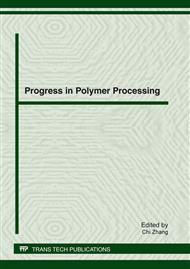p.215
p.220
p.225
p.231
p.237
p.243
p.247
p.253
p.259
Key Parameters Influencing Microcellular Polystyrene Cell Morphology Blowing with Supercritical CO2
Abstract:
Polystyrene microcellular foams blowing with supercritical CO2 were prepared with a novel polymer foam processing simulator. Key parameters influencing Polystyrene cell morphology were investigated. The effect of processing temperature and saturation pressure on cell morphology was observed by scanning electron microscope and the average cell diameter and cell size distribution was calculated. The results show that the cell density decrease and cell size increase with the increase of foaming temperature. The cell density increase and cell size decrease with the increase of saturation pressure. And the cell size distribution shows a narrow distribution at lower foaming temperature and higher saturation pressure.
Info:
Periodical:
Pages:
237-242
Citation:
Online since:
January 2012
Authors:
Price:
Сopyright:
© 2012 Trans Tech Publications Ltd. All Rights Reserved
Share:
Citation:


